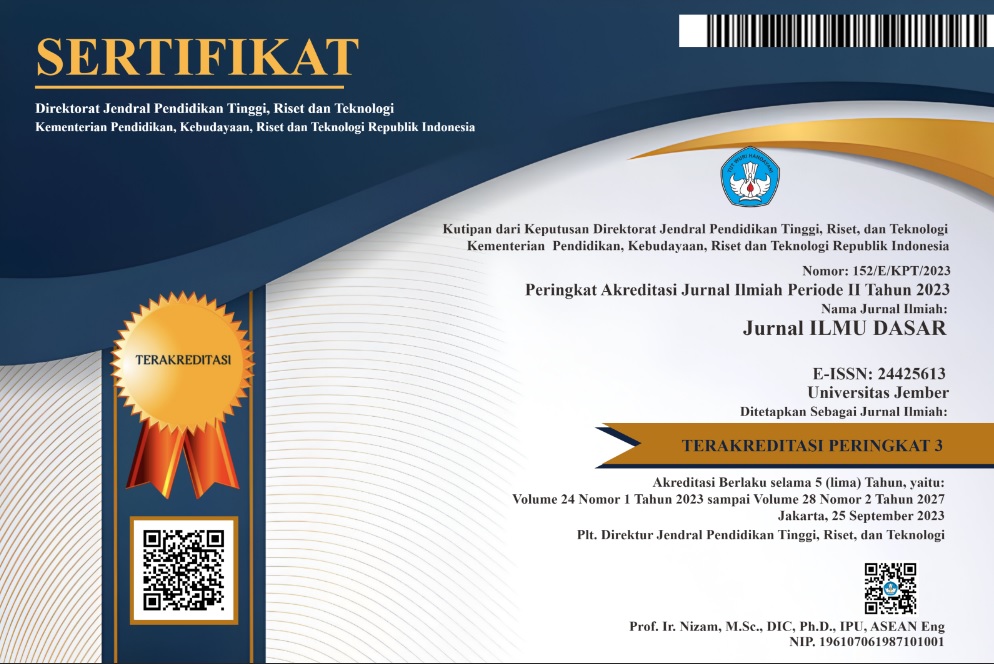Growth Pattern and Degradation Activity of Caffeine-degrading Bacteria Consortium
DOI:
https://doi.org/10.19184/jid.v25i1.32609Keywords:
Caffeine, degradation, consortium, association, resistance, growthAbstract
Caffeine-degrading bacteria can be used as agents to degrade caffeine, thereby reducing the concentration of caffeine in organic waste. The decomposition process is carried out by a single bacterium or a consortium of bacteria. Caffeine-degrading bacteria from Sempol, Bondowoso, namely Acinetobacter gerneri KAFS 47, Paracoccus denitrificans KAFS 16 and Pseudomonas plecoglossicida KAFS 34, could be used as a bacterial consortium to promote caffeine degradation. The aim of this study was to analyze associations between caffeine-degrading bacteria isolates, bacterial resistance to antibiotics, growth patterns, and caffeine degradation of a consortium of caffeine-degrading bacteria, and the correlation of bacterial growth with caffeine degradation. The research method used is an analysis of the association between isolates, the development of bacterial consortium growth patterns, and their analysis based on antibiotic resistance, patterning of caffeine degradation, and correlation test (Pearson) of bacterial growth with caffeine degradation. The result of the association test between bacteria showed that the three bacteria had the potential to be used as a consortium of caffeine-degrading bacteria. A. Gerneri, P. denitrificans, and P. plecoglossicida were resistant to the antibiotic cefixime (100 ppm), erythromycin (50 ppm), lincomycin (50 ppm), metronidazole (50 ppm), and sanprima (50 ppm). The growth of the bacterial consortium (54.779 CFU/mL) was higher than that of P. plecoglossicida (49.277 CFU/mL) and lower than that of A. gerneri (93.481 CFU/mL) and P. denitrificans (84.940 CFU/mL) in incubation time of 4 days. However, the consortium of bacteria and P. plecoglossicida were able to degrade caffeine 24 hours faster (3 days) than the other two single isolates (4 days) to degrade 2.5 g/L caffeine in media to 0%. Bacterial growth due to caffeine degradation has a perfect correlation value (>0. 950) and is negative.
Downloads
References
Arimurti S, Oktavianawati I & Suharjono S. 2021. Isolation and Screening Caffeine-Degrading Bacteria. IOP Conference Series: Earth and Environmental Science. 743(1).
Gomes T, Pereira JA, Ramalhosa E, Casal S, & Baptista P. 2013. Effect of Fresh and Composted Spent Coffee Grounds on Lettuce Growth, Photosynthetic Pigments and Mineral Composition VII Congreso Ibérico de Agroingenieria y Ciencias Horticolas. VII: 1372-1376.
Hamzah A, Phan CW, Abu Bakar NF & Wong KK. 2013. Biodegradation of Crude Oil by Constructed Bacterial Consortia and the Constituent Single Bacteria Isolated from Malaysia. Bioremediation Journal. 17(1): 1-10.
Irsyadah A. 2020. Analisis Pola Pertumbuhan, Degradasi Kafein, dan Profil Protein Bakteri Paracoccus denitrificans KAFS 16 pada Media Kafein. [Skripsi, Universitas Jember].
Iswanto T, Shovitri M, Altway A, Widjaja T, Kusumawati DI & Lisdiyanti P. 2019. Isolation and Identification of Caffeine-degrading Bacteria from Soil, Coffee Pulp Waste and Excreted Coffee Bean in Luwak Feces. Biodiversitas. 20(6): 1580-1587.
Khursheed T, Ansari MYK & Shahab D. 2009. Studies on the Effect of Caffeine on Growth and Yield Parameters in Helianthus annuus L. Variety Modern. Biology and Medicine. 1(2): 56-60.
Kumar KH & Jagadeesh KS. 2016. Microbial Consortia-mediated Plant Defense Against Phytopathogens and Growth Benefits. South Indian Journal of Biological Sciences. 2(4): 395-403.
Malasari V. 2020. Analisis Pertumbuhan dan Profil Protein Bakteri Pendegradasi Kafein Pseudomonas plecoglossicida KAFS 34. [Skripsi, Universitas Jember]
Mulyadi M & Ria SP. 2017. Konsentrasi Hambat Minimum (KHM) Kadar Sampel Alang-Alang (Imperata cylindrica) dalam Etanol Melalui Metode Difusi Cakram. Jurnal Kimia Sains dan Aplikasi. 20(3):130-135.
Poszytek K, Ciezkowska M, Sklodowska A. & Drewniak L. 2016. Microbial Consortium with High Cellulolytic Activity (MCHCA) for Enhanced Biogas Production. Frontiers in Microbiology. 7.
Resti Z, Sulyanti E & Reflin. 2018. Endophytic Bacterial Consortium as Biological Control to Ralstonia solanacearum and Growth Promoter for Chili Plant. PROS SEM NAS MASY BIODIV INDON. 4(2): 208-214.
Rifai MR, Widowati H & Sutanto A. 2020. Uji Sinergis Konsorsia Bakteri Indigen LCN Berkonsorsia Bakteri Tanah di Kebun Percobaan Universitas Muhammadiyah Metro untuk Penyusunan Panduan Praktikum Mikrobiologi. http://scholar.ummetro.ac.id/index.php/biolova/
Sindiana I. 2020. Pola Pertumbuhan dan Profil Protein Bakteri Pendegradasi Kafein Acinetobacter gerneri KAFS 47. [Skripsi Universitas Jember]
Subagiyo S, Margino S & Triyanto T. 2016. Pengaruh Penambahan Berbagai Jenis Sumber Karbon, Nitrogen dan Fosfor pada Medium deMan, Rogosa and Sharpe (MRS) terhadap Pertumbuhan Bakteri Asam Laktat Terpilih yang Diisolasi dari Intestinum Udang Penaeid. Jurnal Kelautan Tropis. 18(3): 127.
Summers RM, Louie TM, Yu CL, Gakhar L, Louie KC & Subramanian M. 2012. Novel, Highly Specific N-demethylases Enable Bacteria to Live on Caffeine and Related Purine Alkaloids. Journal of Bacteriology. 194(8): 2041-2049.
Summers RM, Mohanty SK, Gopishetty S & Subramanian M. 2015. Genetic Characterization of Caffeine Degradation by Bacteria and Its Potential Applications. In Microbial Biotechnology. 8(3): 369-378.
Triono AA & Purwoko AE. 2012. Efektifitas Antibiotik Golongan Sefalosporin dan Kuinolon terhadap Infeksi Saluran Kemih. Mutiara Medika. 12(1): 6-11.
Wasitaningrum IDA. 2009. Uji Resistensi Bakteri Staphylococcus aureus dan Escherichia coli dari Isolat Susu Sapi Segar Terhadap Beberapa Antibiotik. [Skripsi Universitas Muhammadiyah Surakarta].
Wilarsih R. 2019. Profil Penggunaan Obat Antibiotik pada Pasien Paviliun Shofa di Rumah Sakit Muhammadiyah Lamongan. Encephale. 53(1): 59-65.
Win YY, Singh M, Sadiq MB & Anal AK. 2019. Isolation and Identification of Caffeine-degrading Bacteria from Coffee Plantation Area. Food Biotechnology. 33(2): 109-124.
Yanti CA & Akhri I. 2021. Perbedaan Uji Korelasi Pearson, Spearman dan Kendall Tau dalam Menganalisis Kejadian Diare. Jurnal Endurance. 6(1): 51-58.
Yunensa KS. 2016. Pengaruh Kombinasi Antibiotik Ampisilin dan Mnyak Atsiri Kulit Batang Kayu Manis (Cinnamomum burmanni) terhadap Staphylococcus aureus Multiresisten. [Skripsi, Universitas Muhammadiyah Surakarta].








